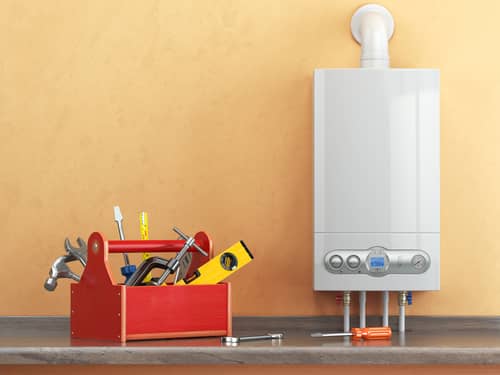
Remember the big switch you made from incandescent light bulbs to CFLs and LEDs? And the change from high-flow to low-flow toilets and from top-loading to front-loading washing machines?
Well now, it’s happening all over again with water heaters, due to new federal regulations. You may have heard about this already if your old water heater started leaking recently and had to be replaced.
As of April 2015, all new water heaters produced for sale in the United States had to become more energy efficient. Since there are still plenty of the old-style heaters in stock for a while, you may be able to install one of them. Some plumbers, in fact, have bought as many old-style heaters as they can. But once that supply runs out, a new energy efficient water heater will be in your future.
Will the new type of water heater work well in your house? There are some drawbacks. If you’re simply replacing a water heater with a capacity of 55 gallons or less, you probably won’t experience too many difficulties. But in replacing a larger heater, you may run into problems.
For all the details, you can read the National Appliance Energy Conservation Act. Basically, the changes are aimed at increasing the energy efficiency for gas and electric water heaters. Here’s what’s required for water heaters with a capacity of 55 gallons or less:
- The impact of the law on gas heaters is that they may need more insulation, some new technology, and possibly electronic ignition instead of a standing pilot light.
- Electric water heaters will need more insulation.
- Water heaters that are manufactured only for solar water heating systems will not be affected.
Homeowners with tanks that have a capacity of 55 or gallons or less will find that a new energy efficient model will generally be three inches wider and three inches taller. These water heaters may also need new and different types of pipes and vents.
All that may be fine if you have a good-sized space in the garage for your water heater. But if you’re using a tight little closet in your house for your water heater, you might have to make changes in the closet or move the heater elsewhere.
It may also take some shopping around to get what you want. “Consumers may find that a product from one manufacturer fits better in their tight space than a similar product from a different manufacturer,” according to the American Council for an Energy-Efficient Economy.
Since the changes can make the new tanks harder to install, the job may cost more. Since the tanks are heavier, what was once a one-person job may now require two workers. What used to be a one-day job might even take several days because of the complications involved. And the days when a DIYer can take on replacing a water heater are probably numbered.
There are some questions that can’t definitely be answered yet about retro-fitting, like how much more it might cost than installing the older models. It’s just like it is with car mufflers. Every car has to have a muffler, but how you install it and what it’s like can be different, depending on the kind of car.
And what about the larger families who use more water and have previously upgraded to a water heater with a capacity of 80 gallons, for example?
They aren’t going to be able to install a model that’s just a larger version of one of those 55-gallon water heaters. That’s because that type of water heater no longer exists in the marketplace. Instead, the larger units being produced have to include design changes like electric heat pumps and/or gas condensing technology to meet the new regulations.
Instead, those homeowners may want to switch to a tankless electric water heater or may have to install two smaller tanks; many customers are doing that.
The good news is that the new units are more energy efficient and can save you money, particularly if you have a larger capacity (80 gallon) tank. For owners of 55-gallon water heaters, the amount saved will be more modest.
So what should you do tomorrow if your water heater starts leaking? If there’s still an old-style heater available for sale, you might want to buy it instead of a new model. Consumer Reports also suggests: “Before you shell out hundreds for a storage tank heater or thousands for a tankless or solar model, see whether your old water heater can be fixed. A corroded storage-tank model is history. But a leaky drain or pressure relief valve or a burned-out heating element can often be fixed.
It’s rare for an older water heater to have a problem that can be fixed that easily. In the long run, many people also want the new technology because they want to save energy.
Note: This article was originally published in the Arizona Republic on August 1st, 2015
Monthly To Do: February | #WaterHeater
###
















